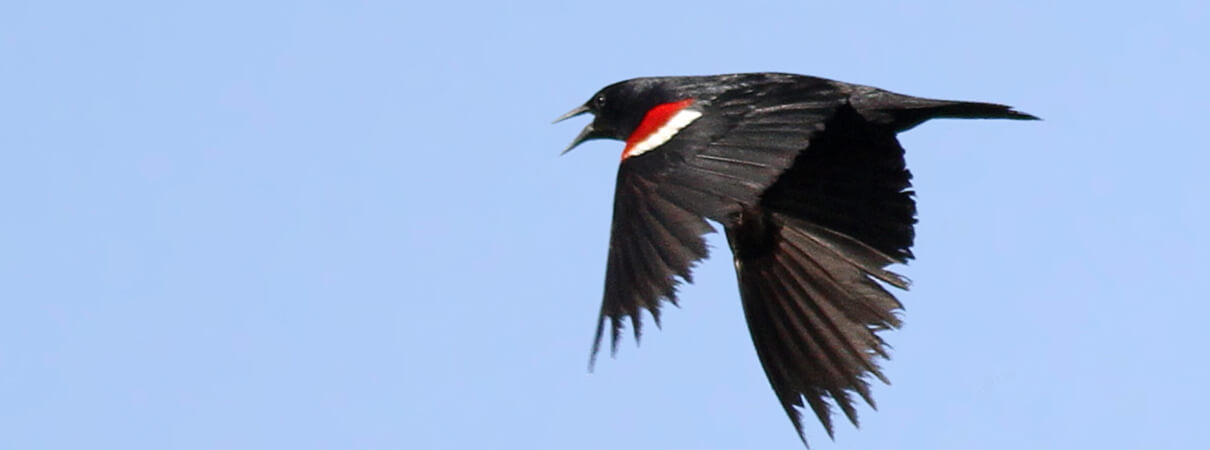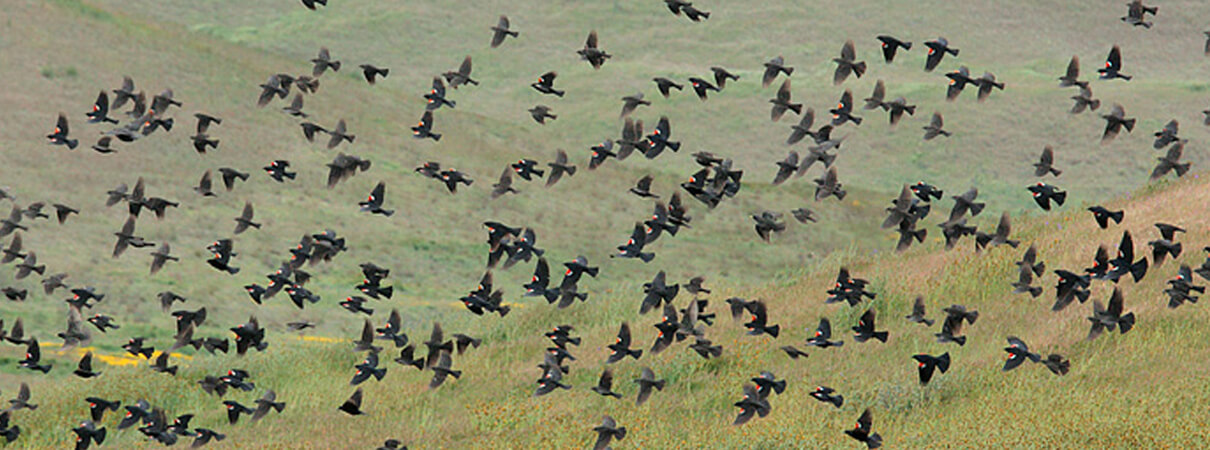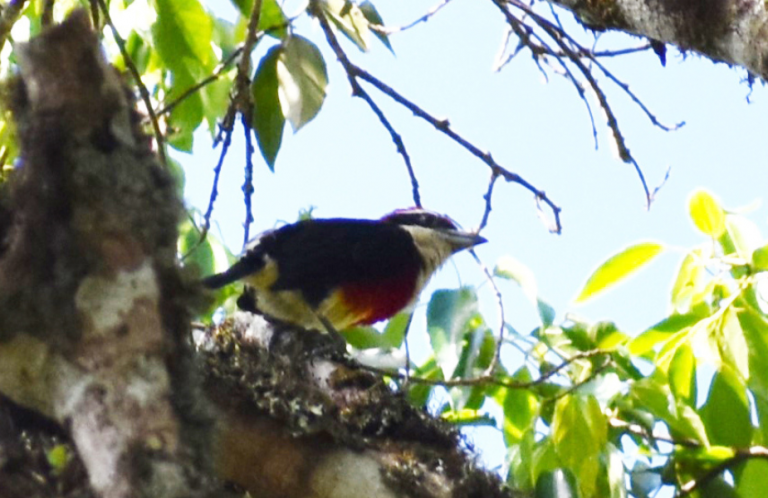On a Mission to Save the Tricolored Blackbird
The Tricolored Blackbird breeds in groups of thousands, forming the largest colonies of any species in North America. Like the Passenger Pigeon, the bird's colonial nature makes it particularly vulnerable to rapid population declines: Tricolored Blackbird populations have plummeted by roughly 66 percent over the past six years due to habitat loss. An estimated 140,000 birds remain; all are in California.
American Bird Conservancy's Western Program, formed in 2015, is on a mission to save the Tricolored Blackbird from extinction. Working with researchers, ranchers, dairymen, state public officials, and several NGOs, ABC aims to identify and conserve key remaining habitat for the species. We recently caught up with David Younkman, ABC's Western Regional Director, to learn more.

Tricolored Blackbird. Photo by Alfred Yan
Audrey Goldfarb: What intrigues you about the Tricolored Blackbird?
David Younkman: Colonial nesting birds are really unique. They have complex and intricate social interactions, they assist each other in foraging, and they provide higher levels of protection from predators by gathering together. The sheer number of birds in one colony can overwhelm the potential impact from a predator.
AG: What are the major challenges for bird conservation in the West?
DY: In the West, you have a landscape that everybody thinks of as open and unbridled, with lots of room. But when you look at it more closely, you find out that it has many stresses and problems, with lot of fragmentation and habitat loss.
These lands can also be subject to overgrazing, unsustainable timber harvest, wildfires, invasive species, drought, and impacts from climate change. All these issues affect our birds and their habitats.
AG: Where are you most likely to find large groups of Tricolored Blackbirds?
DY: Historically, the birds' biggest stronghold was California's Central Valley, where they nested in huge numbers in cattail wetlands. In the 1930s, population estimates ranged into the millions of birds, but in the Central Valley, as in so many other places, the wetland system has been drained and converted to agriculture. In the last century more than 90 percent of the wetlands in the Central Valley have been lost.
Today, Tricolored Blackbirds still occur in the Central Valley stretching up into the Sierra Nevada foothills, and are more patchily distributed in other parts of the state. In order to adapt to the changing landscape, the Tricolored Blackbirds in the San Joaquin part of the Central Valley have set up nesting colonies in silage fields, a crop that is turned into food for cattle.
Unfortunately, the silage gets ripe exactly at the same time that the young birds are fledging. So when dairymen and farmers harvest the silage, they wipe out all the baby birds in the colony in one fell swoop. The adults can escape, but the young can't. So you'll see a whole colony with zero production.

Tricolored Blackbird flock. Photo by Jacob Spendelow
AG: What does the Tricolored Blackbird need to survive?
DY: As with all birds, they need three things to survive: food, water, and shelter. The adults can live on grain that is put out to feed dairy cows, but it doesn't have the right amino acids to allow the females to produce eggs and to enable the young to grow and thrive. Insects give them the right nutrients. So the blackbirds need good nesting habitat near open water and within foraging range of abundant insects to successfully raise chicks.
AG: What other challenges does the species face?
DY: Pest management is a big threat to the birds, especially in the winter when Tricolored Blackbirds congregate with Red-winged Blackbirds. Red-winged Blackbirds are considered agricultural pests and can be shot. Some Tricolored Blackbirds are being shot, too, mistaken as pests.
We also are worried about the impact of insecticides and pesticides on Tricolored Blackbird populations.
AG: What are conservationists doing to address these threats?
DY: It will take efforts from many groups and individuals to save the Tricolored Blackbird. For example, the Natural Resources Conservation Service has a program to pay farmers who have Tricolored Blackbirds in their fields so that they don't harvest the silage before the birds have a chance to fledge. There's a group of people on the Tricolored Blackbird Working Group at the state level—Audubon California is leading this effort—that go out and contact the farmers and get them to stop the harvest.
In the Sacramento Valley, ABC is working with a landowner who has a critical colony we're trying to put a permanent conservation easement on. (A conservation easement is a legally binding agreement with a landowner to assure that the property stays intact and the conservation values stay in place.) If we can do that, we will protect a site that harbors up to 20 percent of the entire blackbird population during the months of May and June. This is a critical piece of an overall conservation effort and will be a great conservation victory when we get it done.

Tricolored Blackbirds in breeding habitat. Photo by Cathy Henry/ Natural Resources Conservation Service, California
AG: How do you know, from year to year, how the bird's population is faring?
DY: Every three years a comprehensive statewide survey provides an update on the status of Tricolored Blackbird populations. In 2014, volunteers conducted the most comprehensive survey ever, with 143 people looking at 800 sites in 41 counties. What the survey found was not good news: the Tricolored Blackbird population had continued to decline rapidly.
The 2014 survey documented that the Tricolored Blackbird population had fallen by 44 percent since 2011—and by 64 percent since 2008—to 145,000 birds. And remember, these birds numbered in the millions only 80 years ago. This is why both the U.S. Fish and Wildlife Service and the California Fish and Wildlife Department are considering listing the bird under both the federal and California Endangered Species Acts.
AG: Will you soon have an idea of how many sites you need to sufficiently recover the population?
DY: There's still a lot we need to understand about these birds and what they need in terms of conservation. The University of California, Davis is currently developing a model to provide estimates of how many populations you would need to meet overall population goals.
In the meantime, ABC and other members of the Tricolored Working Group are trying to put in place some basic conservation agreements with private landowners, farmers, and public land managers, so we don't lose the places we believe are most important.
AG: What can people do to help?
DY: We need people to show concern and provide support. The California Department of Fish and Wildlife is currently reviewing the bird's listing status, and this fall we expect them to release a report on their findings. People can then submit their comments on that report for 30 days after its release.
Right now the Tricolored Blackbird has temporary protection under the California Endangered Species Act while this review is under way. If it the state decides not to list it, the bird will not have any protection except under the Migratory Bird Treaty Act. So this is an important decision.

Tricolored Blackbirds in flight. Photo by Kelly Weintraub, Natural Resources Conservation Service, California
The second thing we need, of course, is financial support to continue our work and to pay for conservation agreements with landowners.
AG: Why is it important to save the Tricolored Blackbird?
DY: Imagine if you had the chance to save the Passenger Pigeon from extinction—once one of the most abundant birds in North America, a bird that “darkened the skies” but now is gone forever.
We at ABC believe it's irresponsible to let such birds go extinct and lose these remarkable examples of nature. Instead, we're working to find people who care, people who can support this effort to save Tricolored Blackbird. Together, we can put this bird back on the path to recovery. That is what ABC and others are working hard to do. That's what we're here for.
(Editor's note: If you'd like to donate to ABC's conservation efforts, click here.)
 Audrey Goldfarb is American Bird Conservancy's writing/communications intern. She is currently an undergraduate at the University of Rochester, where she is pursuing a bachelor's degree in molecular genetics, with minors in journalism and psychology. Audrey grew up in a home visited by many birds, including Wild Turkeys, Eastern Bluebirds, Rose-breasted Grosbeaks, Northern Flickers, and Great Blue Herons.
Audrey Goldfarb is American Bird Conservancy's writing/communications intern. She is currently an undergraduate at the University of Rochester, where she is pursuing a bachelor's degree in molecular genetics, with minors in journalism and psychology. Audrey grew up in a home visited by many birds, including Wild Turkeys, Eastern Bluebirds, Rose-breasted Grosbeaks, Northern Flickers, and Great Blue Herons.


















































